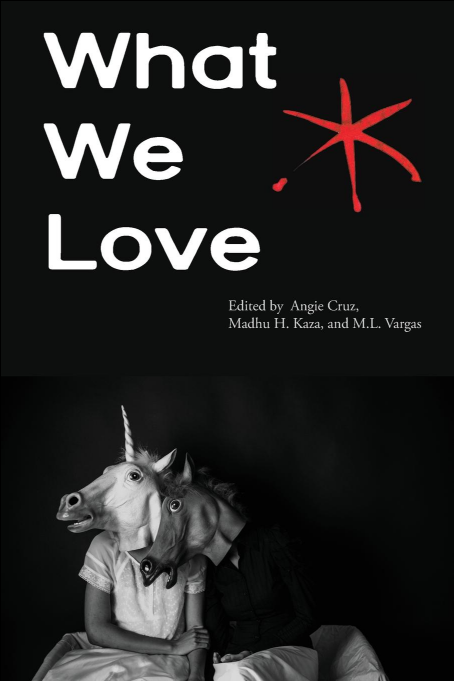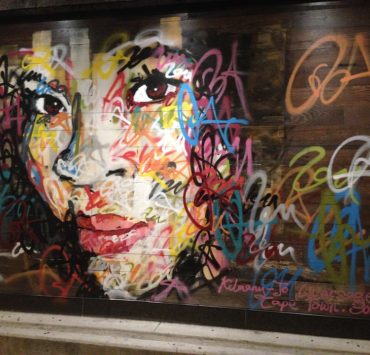
Madhu H. Kaza: When I think of the idea behind “What We Love” I think back to an exhibition that the conceptual artist Fred Wilson curated several years ago for a gallery in New York. The show didn’t have a theme—the theme was basically: Art that Fred Wilson Likes and Wants to Include in His Show. I loved that gesture. Particularly because—if you know Fred Wilson’s work—he is such an incisive thinker about art history, race, and the way that our gaze is shaped by institutions and power. So this was not a scenario in which a white male curator was making the usual move of promoting his personal (or market calculated) taste as the universal standard of greatness. It was far more interesting. It was transparently subjective. I read it as an assertion of freedom, a way of claiming more space for black subjectivity.*
Women and people of color are often boxed in by publishers and cultural institutions—there are a limited number of things that we are supposed to talk about or like or want. An acquaintance of mine, an African American college professor, remarked that her colleagues listen very closely when she talks about race, but they are uninterested in what she might say about gardening or architecture or grandchildren. I want to hear what she thinks about any of these things, whatever is important to her.
“What We Love” was conceived so that we could publish whatever work excited us. I think a basic impulse in editing this issue for me also had to do with bringing a kind of honesty, a baring of our values and aesthetic attitudes to the work. The issue has its own omissions, contradictions, and blind-spots. But I think it’s an exciting place to start. I’d also been thinking of Odysseas Elytis’ poem, “Sun the First,” from a section of Eros, Eros, Eros called “What I Love,” which I recall reading to both of you when we were re-imagining Aster(ix) and dreaming up what this issue could be. The poem includes the lines, “What I love is always being born/ What I love is beginning always.” This is also the first issue produced with our new group of contributing editors. So here we are beginning again with “What We Love.”
Angie Cruz: Those lines in particular alight an aspect of editing Aster(ix), true since its inception, of always beginning again. The journal has had so many rebirths, incarnations. The constant shape shifting of the journal exposes how I personally have been working through and against imagined constraints. I’ve been practicing how to intentionally occupy this potentially liberatory literary space, being more courageous and free, as writers, readers, lovers of things. When we looked through the varied works solicited to us by our expanded community of contributing editors I had to continually ask myself, do I love this? Is it a beautiful work? All of this is subjective, but why isn’t my subjectivity as valid as everyone else’s? And what do I mean by love? In The Fire Next Time, Baldwin describes it this way: “Love takes off the masks that we fear we cannot live without and know we cannot live within. I use the word “love” here not merely in the personal sense but as a state of being, or a state of grace—not in the infantile American sense of being made happy but in the tough and universal sense of quest and daring and growth.” So when reading the works for this issue, I tried to keep asking myself, what’s fresh about this piece, am I moved, puzzled, is it daring?
ML Vargas: If you both remember, a revamping of Aster(ix) came about over a dinner in November, 2015, where we shared our excitement about journals, books and our place among the conversations with which we felt most aligned, most challenged.
The print issue of “What We Love” naturally arose from enacting that original conversation, by bringing more voices to the table, where we are creating a home with good bones and impeccable intentions, so we can share writing that moves us. We revisited and have revised the Aster(ix) vision to embrace the known and unknown; the courageous and the unpredictable; the real and the unreal; to wrestle with the possible and the impossible; jaguar’s chesty roar; magic; what’s censored and omitted; love and devotion. What has come forth, through conversations and connections,reading, rereading and arguing over submissions in Madhu’s bed/oir, was directed by what we love, with love as the torch bearer.
AC: And this has produced an issue that to me reflects an unapologetic freedom. The works are varied, maybe even all over the place in style, themes, but they all inhabit a “sprezzatura of an infant” as described by Agamben in Nudities, where he says “ the ways in which we do not know things are just as important (and perhaps even more important) as the way we know them….an unselfconsciouness.” Beauty and enchantment lies in that space.
When we made the call for this issue, “What We Love,” the editors solicited writers they loved and then we looked at the work and asked ourselves if it was work we loved. And the fun for me was in the ways we disagreed and agreed. All of us are wildly different from each other
and look for different things in our reading. But we discovered how we’re most interested in ensuring that Aster(ix) nurtures and prioritizes works that surprise us and are doing something novel. Dia Felix’s story is a good example of this. And perhaps that is why we chose to start the issue with it. It embodies, like many of the chosen works, the energy, play and seriousness, the wild splat.
MHK: “What We Love” brings together the work of twenty one amazing writers. I’m happy that we were able to include writers who are not based in the U.S.: Vahni Capildeo, Saudamini Deo, Magda Kapa, and Marie NDiaye. I love that there are odd, unlikely resonances between the works. For instance, green haunts the women in Marie NDiaye’s Self-Portrait in Green. Vahni Capildeo’s piece ends with the lines, “Yesterday I walked again in the green space./ This has been thought for you.” Capildeo’s work is dense and beautiful in its own right, but these lines lingered in my mind differently in connection with NDiaye’s work. And I read NDiaye’s work in conversation with Miranda Mellis’ excerpt from The Spokes. Both pieces explore difficult relationships between women through otherworldly encounters and both are gorgeously written.
I also appreciate how different many of the works in the issue are. We did not work from one idea or voice or aesthetic viewpoint. Apart from the three of us, there were a number of other editors who contributed to this issue—I would like to acknowledge Arielle Greenberg, Yona Harvey, Idra Novey, Emily Raboteau, Zohra Saed, Purvi Shah, and Sun Yung Shin. This issue contains work that they sent our way, and so it really is a collective statement of what we love.
I want to mention, too, a piece that is not in this issue but which was important to our thinking when we began working together to re-launch Aster(ix) with a new collective of editors and contributing editors. Jenelle Troxell wrote a piece for Aster(ix) online about Margaret Anderson and Jane Heap. Anderson and Heap were founders of The Little Review, an early 20th century journal that published modernist, feminist, surrealist, queer, anarchist writers. We’re not modernist white women—I think we and our aesthetics are more all over the place—but the spirit of their work informed our process.
AC: Admittedly, working with Jenelle on her short piece highlighted why we should continue publishing creative criticism and also contextualized the work we have been doing for so many years. I was quite seduced by the history of little magazines. So many of the important ones (not surprisingly) were started by women and at their own expense and sacrifice. But aside from the sacrifices of both time and money that it takes to keep these efforts going, what I loved about Heap and Anderson was the boudoir description. In Heap’s meeting room, editors and contributors would gather on a swinging bed in the middle of the room because editing is an intimate act. And when looking for work they stressed how they didn’t want to be bored. Boredom was their litmus and that felt quite liberatory to me. Why can’t we choose work that does not bore us? Us meaning women of color. Us meaning politicized women of color and our allies. How can we recreate a space where we can also “fight” and work through what is beauty, what is important, what works should earn a space in this journal we are nurturing?
MLV: In thinking about the future of Aster(ix), I’d also like to swing back to the past. Thanks to Jenelle, we can celebrate this moment as 100 years after Jane Heap and Margaret Anderson. While we are addressing the public possibilities, we are also deeply interested in the “life inspired.” What is the criteria of the wild imagination for us? I am guided by Heap and Anderson’s “libidinal charge” and Audre Lorde’s “erotic`electrical charge” and always, Frederico García Lorca’s duende. Being held by such forces allows us to ask, in Clarice Lispector’s words, what would one say in the “madness of sincerity” and in the “madness of free invention?” How does this wild dream? What is its form? Who vows to participate in its revelation?
As Gloria Anzaldua’s daughters we court the wound, the edges, where we find possible and impossible exchanges. I very much love how Aisha Durham, an Aster(ix) contributor, defined both a challenge and an inspiration: “I live on the margins of my discipline.” The September 1916 issue of the Little Review left thirteen pages blank as a space for the missing content in response to a call for creative criticism. The thirteen blank pages in this issue are my invitation for wild imaginative im/possibilities, play, both on the page and in the life, wherever the blurrings of the private and the public create new encounters, new galaxies. This blurring fueled by love, is our transformative future.
* Though I recall the exhibition described here, I can’t find any documentation of it. So there is a small chance that somehow I transposed events and made up this story. That would not negate its essential truth.

Angie Cruz's novel, DOMINICANA is the inaugural bookpick for GMA book club, and the Wordup Uptown Reads selection for 2019. It was also longlisted for the Andrew Carnegie award in excellence in fiction for 2019. It was named most anticipated/ best book in 2019 by Time, Newsweek, People, Oprah Magazine, The Washington Post, The New York Times, and Esquire. Cruz is the author of two other novels, Soledad and Let It Rain Coffee. She's the founder and Editor-in-chief of the award winning literary journal, Aster(ix)and an Associate professor at University of Pittsburgh where she teaches in the MFA program. She splits her time between Pittsburgh, New York, and Turin.







